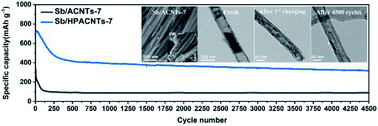Confining Sb nanoparticles in bamboo-like hierarchical porous aligned carbon nanotubes for use as an anode for sodium ion batteries with ultralong cycling performance†
Abstract
Alloy-based anode materials have been widely studied for sodium-ion batteries due to their high specific capacities. However, they suffer from huge volume changes during cycling, and how to improve the structural durability of the anodes is still challenging. Herein, the composite of Sb nanoparticles being confined in bamboo-like hierarchical porous N-doped aligned carbon nanotubes (HPACNTs) arrays has been constructed through a combination of solution impregnation, melting diffusion and reduction. Bamboo-like HPACNTs, acting as Sb reservoirs with excellent physical confinement, can ensure the integral structural stability of the Sb/HPACNTs composite anode. Furthermore, smooth channels, hierarchical pores and bamboo knot-like graphene layers in the inner cavities of HPACNTs effectively modulate the volume effect of Sb, as well as result in smooth electron and ion transport during cycling. Attributed to these structural advantages, the as-developed Sb/HPACNTs composite shows an ultralong cycling stability with a reversible capacity of 318 mA h g−1 after 4500 cycles at a current density of 1 A g−1. This work provides a significant strategy for Sb/HPACNTs architectures, which could be extended to other alloy-based anodes for high performance sodium storage.



 Please wait while we load your content...
Please wait while we load your content...